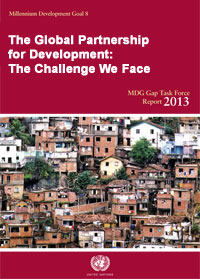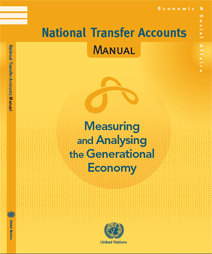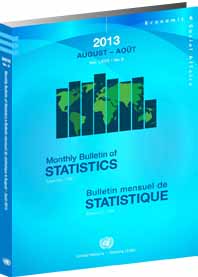The MDG Gap Task Force Report 2013
 The report, entitled, “The Global Partnership for Development: The Challenge We Face,” tracks delivery on commitments listed under Millennium Development Goal 8—the global partnership for development— including aid, trade, debt relief, access to essential medicines and access to new technologies.
The report, entitled, “The Global Partnership for Development: The Challenge We Face,” tracks delivery on commitments listed under Millennium Development Goal 8—the global partnership for development— including aid, trade, debt relief, access to essential medicines and access to new technologies.
“The picture is mixed,” Mr. Ban said. “We can do better. The best way to prepare for the post-2015 era is to demonstrate that when the international community commits to a global partnership for development, it means it and directs its resources to where they are most needed.”
To deepen the global partnership of UN Member States, international organizations, civil society, the private sector and others, the report makes many recommendations, including for stopping tax evasion, strengthening manufacturing safety standards, dealing with unsustainable debt and improving financial regulation and the rules for global trade, while also asking all partners to live up to their commitments already made in support of achieving the MDGs.
To download: http://www.un.org/en/development/desa/policy/mdg_gap/index.shtml
National Transfer Accounts (NTA)
 The publication provides a coherent accounting framework of economic flows from one age group or generation to another, typically for a national population in a given calendar year. This manual presents the concepts, methods and estimation procedures to measure these flows over the life-cycle. The NTA estimates are useful to understand and analyse the implications of changing age structures for the fiscal sustainability of social programs, the accumulation of physical and human capital, economic growth, and familial support for children, youth and older persons.
The publication provides a coherent accounting framework of economic flows from one age group or generation to another, typically for a national population in a given calendar year. This manual presents the concepts, methods and estimation procedures to measure these flows over the life-cycle. The NTA estimates are useful to understand and analyse the implications of changing age structures for the fiscal sustainability of social programs, the accumulation of physical and human capital, economic growth, and familial support for children, youth and older persons.
National Transfer Accounts are consistent with the System of National Accounts (SNA), and provide measures by single years of age of the sources of income (labour, assets, receipt of public and private transfers), and the uses of income (final private and public consumption, transfer payments of individuals to their families and the government, and saving). The manual builds on work carried out for more than a decade by members of the NTA global network, reflected in the book Population Aging and the Generational Economy (Lee and Mason, editors and main authors, 2011).
This manual, produced as part of a UN Development Account project (ROA167), is meant to support capacity development efforts, assisting researchers from countries all over the world to construct National Transfer Accounts, and to interpret and analyse them for relevant policy issues.
For more information: http://www.un.org/en/development/desa/population/publications/development/NTA_Manual.shtml
Trends in International Migrant Stock: The 2013 Revision
The publication launched by UN DESA’s Population Division consists of global estimates of the number of international migrants for 232 countries or areas of the world. The estimates cover the years 1990, 2000, 2010 and 2013 and are disaggregated by age, sex and country of origin and destination. The publication is available as an online database. A website on www.unmigration.org, dedicated to the launch of this publication, also displays a wall chart, three fact sheets focusing on different aspect of the new estimates, and a press release, video and statement of the Director from a press briefing.
Overall, the estimates show that more people than ever are living abroad. The number of international migrants worldwide has reached 232 million in 2013, up from 154 million in 1990. About 6 out of every 10 international migrants are living in the developed regions, or the global North. Although international migrants account for a small share of the total population (about 3 per cent), the effects of migration are much broader, since it affects migrants and non-migrants alike in countries of origin, destination and transit. Most international migrants are of working age and roughly half of them are women. The data also reveal that South-to-South movements were the most common form of migration around 1990. Since 2000, migration from South to North has become as common as migration between countries of the global South. In 2013, about 82.3 million international migrants who were born in the South are living as migrants in other countries of the South. About 81.9 million international migrants who originated in the South are now living in the North.
United Nations Member States and other stakeholders have made repeated calls for an improved evidence base on international migration. The Population Division has worked hard to respond to these requests and is hopeful that these new estimates will inform the High-level Dialogue in October and contribute to evidence-based policy-making and informed public debate.
For more information: http://esa.un.org/unmigration/wallchart2013.htm
Statistical compilations
Monthly Bulletin of Statistics and MBS Online
 The Monthly Bulletin of Statistics presents current economic and social statistics for more than 200 countries and territories of the world. It contains over 50 tables of monthly and/or bimonthly, quarterly and annual data on a variety of subjects illustrating important economic trends and developments, including population, prices, employment and earnings, energy, manufacturing, transport, construction, international merchandise trade and finance.
The Monthly Bulletin of Statistics presents current economic and social statistics for more than 200 countries and territories of the world. It contains over 50 tables of monthly and/or bimonthly, quarterly and annual data on a variety of subjects illustrating important economic trends and developments, including population, prices, employment and earnings, energy, manufacturing, transport, construction, international merchandise trade and finance.
Vol. LXVII – No. 8, August 2013
In addition to the regular recurrent monthly tables, this issue includes the quarterly and bimonthly tables: Retail price indices relating to living expenditures of United Nations officials; Earnings in manufacturing, by sex; Total exports and imports by regions: volume and unit value indices and terms of trade.
For more information: http://unstats.un.org/unsd/mbs
Outreach material
Sustainable Development in Action – Issue 7, Volume 8
The latest newsletter, published by UN DESA’s Division for Sustainable Development, aims to highlight the work carried out by Member States, the UN, Major Groups and other relevant stakeholders in implementing sustainable development and leading the way to the Future We Want.
Read full issue: http://sustainabledevelopment.un.org/index.php?menu=1672
DESA NGO News
The September issue published by UN DESA’s NGO Branch, provides the most up-to-date information on news and upcoming events of interest to civil society at UN headquarters in New York, Geneva and elsewhere.
Read full issue: http://csonet.org/index.php?menu=109
Youth Flash Newsletter
August issue features an article on “Young people celebrate International Youth Day 2013”. The newsletter is published by UN DESA’s Division for Social Policy and Development Focal Point on Youth to keep the public informed about the work of the UN on youth issues. It is prepared with input from UN offices, agencies, and from youth organizations around the world.
Read full issue at: http://undesadspd.org/Youth/YouthFlashNewsletter/2013/August.aspx
